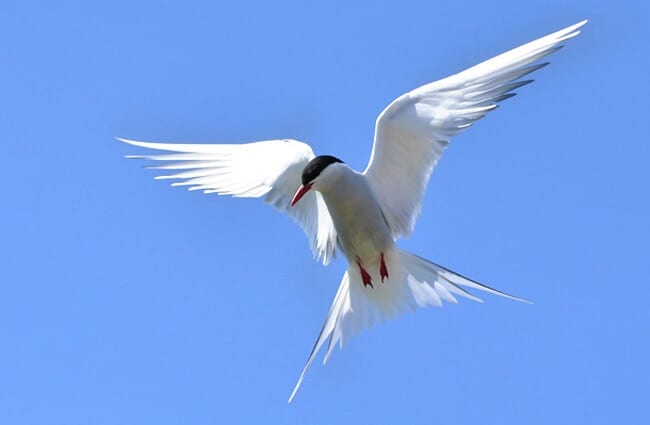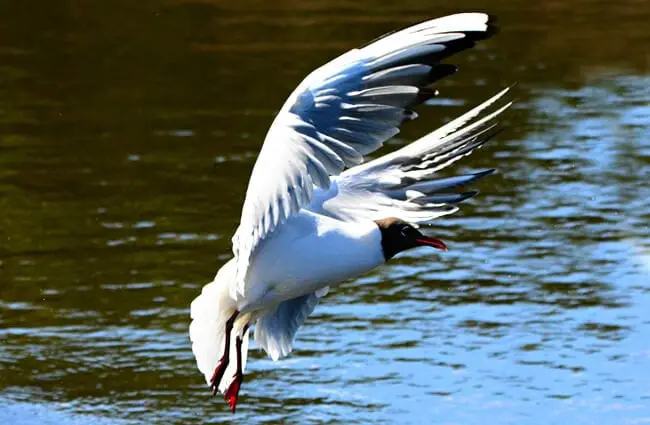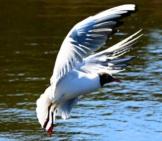The Tern is a large group of seagoing birds in the Laridae family, along with seagulls and skimmers. There are 45 different species of these birds, all in the Sterninae subfamily. While each species is different, all Terns are long-bodied, with disproportionately short legs and long tails. These birds have true worldwide distribution, including Antarctica. Read on to learn about the Tern.
Description of the Tern
Even though there are many different species of these birds, they all share several characteristics. For their body length, they have comparatively (and comically) short legs. Their bodies and tails are quite long and teardrop shaped.
These birds also have long wings, which are quite narrow and sometimes noticeably pointed at the tips. They range in size, from about 9 in. to 21 in. long. The heaviest weigh up to 1.5 lbs. or so.
Interesting Facts About the Tern
Terns are a diverse and interesting group of birds. Each species is unique and interesting in itself, learn more about some of the different species below.
- Least Tern – This species is the smallest of the Terns, at just eight or nine inches long. When there aren’t enough spots to nest on the beach, sometimes Least Terns build their nests on flat rooftops. Unfortunately, the tar beneath the gravel sometimes burns them or gets stuck in their feathers.
- Caspian Tern – The Caspian is the largest of these bird species in the world, at an impressive 18 – 21 in. long. Like many Terns, this species breeds in large colonies. In fact, one colony on the Columbia River hosts 12,000 adult Caspians every year!
- Arctic Tern – This little bird is the world record holder for the longest migration of any animal. Every year, these birds migrate from the North Pole to the South Pole and back. In a single year, this foot-long bird travels at least 25,000 miles, and some travel upwards of 40,000 miles!
- Chinese Crested Tern – The Chinese Crested Tern is at immediate risk of extinction. Researchers estimate that there are fewer than 50 individuals left in the wild today. Humans collecting and eating their eggs, and destroying their wetland habitat, are the primary reasons that this species is on the brink of extinction. The IUCN lists this species as Critically Endangered.
Habitat of the Tern
Terns live in a variety of different habitats, but they are all closely associated with water. Their habitats are primarily marine, or saltwater, more so than freshwater or brackish water.
Some of the many ecosystems that they inhabit include beaches, sandbars, mudflats, estuaries, rivers, wetlands, and more. Some species spend their entire time at sea while they are not breeding by floating on the water when they need to rest, while others rest along beaches or coasts.
Distribution of the Tern
There are many different species of Terns, with different ranges and distributions. All the combined species, and even some individual species alone, have worldwide distribution.
They inhabit coasts and oceans of every single continent on earth, including Antarctica. In fact, various species breed on every continent. These birds live and breed from the Arctic Circle all the way to Antarctica.
Diet of the Tern
Terns are primarily piscivores, which means that they primarily eat fish and other seafood. Their exact diet varies based on the species and the region they live in.
Some eat only a few types of fish while breeding or migrating, but most eat just about anything that is plentiful and easy to catch. Some of their different prey items include small fish, squid, shrimp, krill, crabs, and even insects, lizards, and small mammals.
Tern and Human Interaction
Humans impact Terns in numerous ways, some of which are highly detrimental to their populations. Hunting and collecting eggs directly impact these birds, and is more common in different regions. Overfishing of their prey species, such as sand eels, also causes drastic population decline and reproductive failure.
Habitat destruction and pollution is a problem for many different species of Terns. The consequences of these human interactions vary from species to species. Some species are common and have booming populations, while others are rare and declining.
Domestication
Humans have not domesticated Terns in any way.
Does the Tern Make a Good Pet
No, Terns do not make good pets. This may be a repetitive argument, but animals that eat fish have incredibly pungent and foul feces. Trust us, you do not want one of these birds pooping all over your house! Also, in most places it is illegal to own a Tern as a pet.
Tern Care
While in zoos or aquariums, these birds often live in enclosures with other shorebirds or seabirds, like sandpipers or seagulls. Their habitats have plenty of shallow water for them to forage and bathe in, as well as sandy beaches and a variety of perches to rest on.
Zookeepers feed them a variety of fish and other types of seafood, like krill, shrimp, crabs, squid, and more. These birds usually come to live in zoos if they become injured in the wild and cannot survive on their own any longer.
Behavior of the Tern
Most species of these birds migrate yearly between their wintering grounds and their breeding colonies, and back. Outside of the breeding season, most of them are social and live in small flocks.
During the breeding season, these birds congregate in large numbers at colony locations. However, these colonies are not particularly social, and each pair establishes their own small nesting territory. Pairs do not tolerate their neighbors encroaching on them.
Reproduction of the Tern
Most Terns nest on cliffs or islands, and do not build any type of nest. The female lays between one and three eggs per clutch, and incubation varies between three weeks and a month long.
Both parents participate in incubation and chick rearing duties. It takes about a month for the chicks to learn how to fly, sometimes longer if the food supply is poor. Once the chicks are flying, the parents and the young all migrate back to their wintering grounds together before parting ways.













![Red Angus Closeup of a beautiful Red Angus cowPhoto by: U.S. Department of Agriculture [pubic domain]https://creativecommons.org/licenses/by/2.0/](https://animals.net/wp-content/uploads/2020/03/Red-Angus-4-238x178.jpg)












![Red Angus Closeup of a beautiful Red Angus cowPhoto by: U.S. Department of Agriculture [pubic domain]https://creativecommons.org/licenses/by/2.0/](https://animals.net/wp-content/uploads/2020/03/Red-Angus-4-100x75.jpg)

